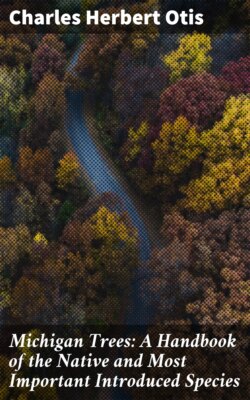Читать книгу Michigan Trees: A Handbook of the Native and Most Important Introduced Species - Charles Herbert Otis - Страница 4
На сайте Литреса книга снята с продажи.
INTRODUCTION
ОглавлениеTable of Contents
The idea of a bulletin on Michigan trees was first suggested by Prof. Volney M. Spalding. It was thought that a bulletin devoted entirely to the study of certain phases of tree life in Michigan would stimulate interest in the study of our trees, and influence many more people to associate themselves with the growing number of tree lovers and with the supporters of the movement for better forest conditions in the state.
The bulletin has been under consideration for a number of years and much of the material given herein has been used in the classes in forest botany at the University of Michigan. It remained, however, for the present Curator of the Botanical Garden and Arboretum to get the material into shape for publication, and the present bulletin is the result of his industry and perseverance. The preparation of the drawings and manuscript has been made by him in connection with his work in the Garden.
The distinctive feature of the bulletin lies in its keys. The keys commonly published are based upon characters which are present but a short time during the year, or which can be used only by an advanced student of botany. This bulletin presents two keys. One is based upon characters which are present all summer; the other uses the winter characters as a basis for identification. By the use of the keys any person should be able to name and learn the characteristics of the trees of Michigan at any time of the year. These keys should prove of special value to our students in the public schools, to members of nature study clubs, and to the students in the forestry schools of the state.
The order of arrangement and the nomenclature are essentially those of “Gray’s New Manual of Botany.” Following a tendency which is steadily gaining favor, all species names are printed with a small letter, regardless of their origin. For the convenience of the general reader, other scientific names which are found in botanical manuals in common use are printed in parenthesis. In the case of exotics which are not included in the Manual, other authorities have been followed. Sudworth’s “Check List of the Forest Trees of the United States” (U. S. Dept. Agr., Div. Forestry, Bul. 17) is in most cases authority for the common names. They are names appearing in common use today in some part of the state. The first name given is that recommended by Sudworth for general use.
The drawings have been made from living or herbarium material and are original. They are accurately drawn to a scale, which is given in each case. In their preparation the author has endeavored to call attention to the salient characters. In the drawings of buds and twigs certain points, bundle-scars, etc., have been emphasized more than is natural. In the descriptions the attempt has been made to bring out those points of similarity and contrast which are most useful for identification.
As the bulletin is not written especially for technical students of botany, the author thought best to use as few technical terms as possible in the descriptions. In some cases it was impossible to avoid such terms, but with the help of the glossary the meaning can be easily understood. Any person desiring to get a more complete knowledge of trees should consult one of the larger manuals. The arrangement used for the illustration and discussion of each single tree makes it possible for the student to compare the drawings with the description without turning a page.
It is believed that with the aid of the drawings and descriptions given in this bulletin any person will be able to name the trees which grow in his yard, park, or woodlot. If, however, any difficulty is found in naming the trees, the Curator will be glad to name any specimens which may be mailed to him. He would be glad to get in touch with persons interested in Michigan trees and to receive any additional information relating to the subject. Data concerning the distribution of the trees in the state, and the addition of other Michigan trees to the present list would be of especial value.
George Plumer Burns.
